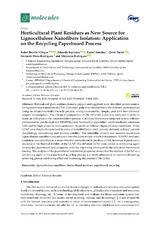Mostrar el registro sencillo del ítem
Horticultural Plant Residues as New Source for Lignocellulose Nanofibers Isolation: Application on the Recycling Paperboard Process
| dc.contributor.author | Bascón-Villegas, Isabel | |
| dc.contributor.author | Espinosa, E. | |
| dc.contributor.author | Sánchez, Rafael | |
| dc.contributor.author | Tarrés, Quim | |
| dc.contributor.author | Pérez-Rodríguez, Fernando | |
| dc.contributor.author | Rodríguez, Alejandro | |
| dc.date.accessioned | 2020-07-18T19:04:04Z | |
| dc.date.available | 2020-07-18T19:04:04Z | |
| dc.date.issued | 2020 | |
| dc.identifier.uri | http://hdl.handle.net/10396/20315 | |
| dc.description.abstract | Horticultural plant residues (tomato, pepper, and eggplant) were identified as new sources for lignocellulose nanofibers (LCNF). Cellulosic pulp was obtained from the different plant residues using an environmentally friendly process, energy-sustainable, simple, and with low-chemical reagent consumption. The chemical composition of the obtained pulps was analyzed in order to study its influence in the nanofibrillation process. Cellulosic fibers were subjected to two different pretreatments, mechanical and TEMPO(2,2,6,6-Tetramethyl-piperidin-1-oxyl)-mediated oxidation, followed by high-pressure homogenization to produce different lignocellulose nanofibers. Then, LCNF were deeply characterized in terms of nanofibrillation yield, cationic demand, carboxyl content, morphology, crystallinity, and thermal stability. The suitability of each raw material to produce lignocellulose nanofibers was analyzed from the point of view of each pretreatment. TEMPO-mediated oxidation was identified as a more effective pretreatment to produce LCNF, however, it produces a decrease in the thermal stability of the LCNF. The different LCNF were added as reinforcing agent on recycled paperboard and compared with the improving produced by the industrial mechanical beating. The analysis of the papersheets’ mechanical properties shows that the addition of LCNF as a reinforcing agent in the paperboard recycling process is a viable alternative to mechanical beating, achieving greater reinforcing effect and increasing the products’ life cycles. | es_ES |
| dc.format.mimetype | application/pdf | es_ES |
| dc.language.iso | eng | es_ES |
| dc.publisher | MDPI | es_ES |
| dc.rights | https://creativecommons.org/licenses/by/4.0/ | es_ES |
| dc.source | Molecules 25(14), 3275 (2020) | es_ES |
| dc.subject | Lignocellulose nanofibers | es_ES |
| dc.subject | Horticultural residues | es_ES |
| dc.subject | Paperboard | es_ES |
| dc.subject | Recycling | es_ES |
| dc.title | Horticultural Plant Residues as New Source for Lignocellulose Nanofibers Isolation: Application on the Recycling Paperboard Process | es_ES |
| dc.type | info:eu-repo/semantics/article | es_ES |
| dc.relation.publisherversion | http://dx.doi.org/10.3390/molecules25143275 | es_ES |
| dc.relation.projectID | Gobierno de España. CTQ2016-78729-R | es_ES |
| dc.rights.accessRights | info:eu-repo/semantics/openAccess | es_ES |

